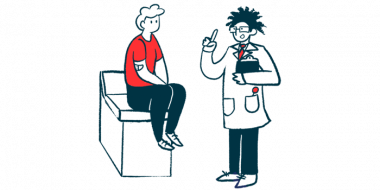PT procedures help SMA patient get comfortable in new wheelchair
Coccyx mobilization, shockwave, dry needling among treatments

During the past few weeks, my patient with spinal muscular atrophy (SMA), Michael, has been adjusting to a new wheelchair. While he’s been in his new chair, he’s had discomfort along his right hip.
Due to this increase in discomfort, we have been transferring him each week out of his chair and trying different techniques and modalities to improve his sitting tolerance. He also has sought the consultation of a neurosurgeon to perform any injections or surgeries that would improve his comfort.
We have continued the coccyx mobilizations due to success with improving comfort in the past. This is performed with Michael lying on his left side while I mobilize his coccyx while attempting to loosen muscular attachments as well. This mobilization has given Michael anywhere from two to four weeks of relief previously when he was using his old chair. However, in this new chair, he only receives minimal relief for a few hours. We decided to perform other modalities to attempt to prolong comfort in his chair.
Shockwave was the first modality we performed after Michael’s transition into his new chair. This activity was performed with Michael lying on his left side with his right side up on the mat. The shockwave uses a probe that delivers high-energy sound waves to increase blood flow to the area and initiate a healing process. This was done around Michael’s coccyx and right coccygeus musculature, which is where he feels the most pain. This activity, while uncomfortable, was not painful for him. He received slight relief for a day or two, although this activity would need to be performed a few more times before deciding the results as far as relief.
Dry needling around the right coccygeus and sacrum was the second activity performed. Michael was in the same position, lying on his left side with his right side up. The needles were placed along the right coccygeus musculature as well as the sacral attachment of the piriformis. These areas were chosen secondary to where Michael feels the most pain and discomfort. Next, electrodes were attached to the needles to perform stimulation into the muscles to provide more relaxation. This procedure is essentially pain-free for Michael and allowed him to sit comfortably for the next two days.
Michael sought advice from a neurosurgeon over the past few weeks in regard to possibly having a rhizotomy, which deadens painful nerve fibers. Because this area is abundant in nerve fibers, the surgeon wouldn’t be able to perform this procedure, but he said the pain could be stemming from inflammation in the area due to increased pressure in the new chair. He advised Michael to make an appointment to receive a steroid injection, which would help reduce some of the inflammation, and could provide from two to six months of relief. Michael also received a prescription for Tylenol 3 with codeine to help with pain.
After this injection, we will reassess what is most helpful and continue to proceed. We’ll continue to adjust and progress with whatever this new chair brings and continue to improve Michael’s function and comfort throughout the next few months.
Patient perspective
It’s amazing how little aches and pains can have a detrimental impact on someone’s life. I knew that it would take me quite a while to get used to my new wheelchair. For the first 58 years of my life, all of my wheelchairs had sling seats. These seats were made of fabric that would stretch from one side of the chair to the other forming the area where the person would sit. The problem with this type of material was that over time, it would stretch.
Now, the majority of the wheelchair manufacturers use a hardpan seat. This is usually a piece of flat aluminum or other hard surface that forms the seat. This helps to not damage the hips, but also requires the patient have a very good cushion to sit on.
I’m fortunate to have a dedicated team of physical therapists and massage therapists, and without them, this journey that I’m going through would be virtually impossible for me to handle on my own. To be honest, I don’t see how any SMA patient can go through life without a physical therapist.



